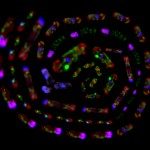Link to Pubmed [PMID] – 23204364
Microbiol. Mol. Biol. Rev. 2012 Dec;76(4):721-39
Forced interspecific hybridization has been used in yeasts for many years to study speciation or to construct artificial strains with novel fermentative and metabolic properties. Recent genome analyses indicate that natural hybrids are also generated spontaneously between yeasts belonging to distinct species, creating lineages with novel phenotypes, varied genetic stability, or altered virulence in the case of pathogens. Large segmental introgressions from evolutionarily distant species are also visible in some yeast genomes, suggesting that interspecific genetic exchanges occur during evolution. The origin of this phenomenon remains unclear, but it is likely based on weak prezygotic barriers, limited Dobzhansky-Muller (DM) incompatibilities, and rapid clonal expansions. Newly formed interspecies hybrids suffer rapid changes in the genetic contribution of each parent, including chromosome loss or aneuploidy, translocations, and loss of heterozygosity, that, except in a few recently studied cases, remain to be characterized more precisely at the genomic level by use of modern technologies. We review here known cases of natural or artificially formed interspecies hybrids between yeasts and discuss their potential importance in terms of genome evolution. Problems of meiotic fertility, ploidy constraint, gene and gene product compatibility, and nucleomitochondrial interactions are discussed and placed in the context of other known mechanisms of yeast genome evolution as a model for eukaryotes.

